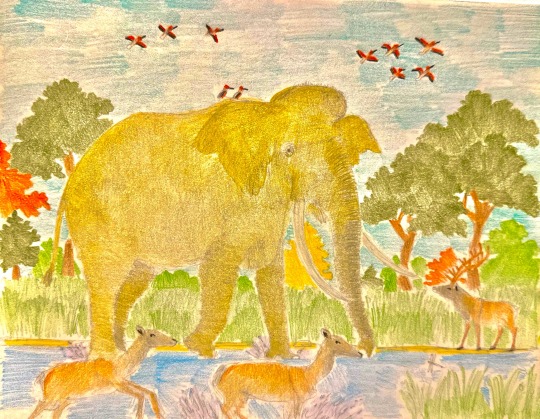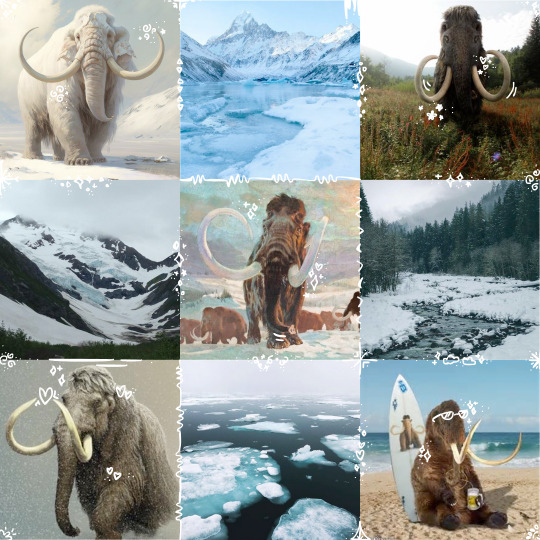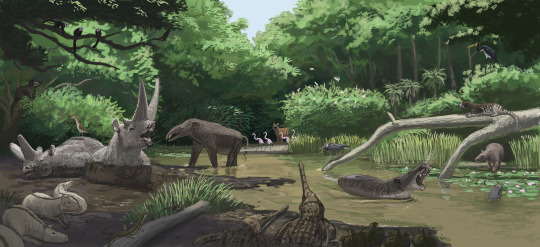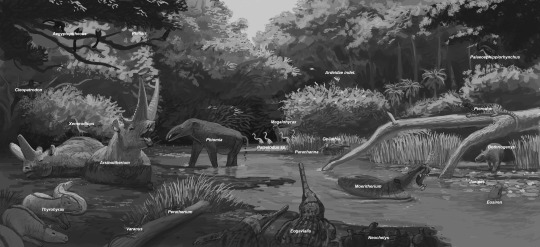#Proboscideans
Explore tagged Tumblr posts
Text





Proboscideans! I definitely need to cover this group a lot more, especially for a group that's covered 60 million years!
Moeritherium - Platybelodon - Deinotherium
Mammoth - Mastodon
Stickers || Phone Wallpapers Masterlist
#art#my art#paleoart#paleontology#science#illustration#cenozoic#proboscideans#elephants#moeritherium#platybelodon#deinotherium#mammoth#mastodon
228 notes
·
View notes
Text
🧬DNA sequencing has revealed that elephants belong in a superorder called Afrotheria—meet their closest relatives!
🐘Learn more at the Museum’s new exhibition The Secret World of Elephants. Discover new science about both ancient and modern elephants, see full-scale models of proboscideans, and more.
🦃Visiting the Museum this Thanksgiving? Best availability is on Monday and Tuesday of that week. Here are a few tips!
#science#amnh#museum#natural history#nature#animals#elephants#proboscideans#did you know#fact of the day#hyrax#manatee#dugong#sea cow#afrotheria#things to do in new york city#animal kingdom#stem
581 notes
·
View notes
Text

Ieva Trinkūnaitė (Lithuanian, 1997) - Endless Nostalgia (2022)
141 notes
·
View notes
Text
youtube
Charming Elephant Cheekily Halts Traffic for Treats | Asia | BBC Earth
In Sri Lanka, Asian elephants live in higher densities than anywhere else on Earth. With people never far away, dangers are present but so are opportunities in terms of getting a cheeky meal.
Taken from 'Asia' (2024) Vast deserts, dense jungles, polar landscapes and tropical seas are explored in this dazzling journey across Earth's biggest continent, Asia. From the vast Arabian Desert to the unexplored jungles of Indonesia; the biting polar wilderness of Siberia to the tropical coral seas of the Indian Ocean. Dramatic wildlife stories are captured in extraordinary locations, including the Tibetan plateau, the Gobi Desert and the Himalayas. The series features rare species of bears, rhinos and big cats, and showcases the surprising variety of animals that thrive in Asia's urban environments. Welcome to BBC EARTH! The world is an amazing place full of stories, beauty and natural wonder. Here you'll find 50 years worth of entertaining and thought-provoking natural history content. Dramatic, rare, and exclusive, nature doesn't get more exciting than this.
#fantastic elephants#elephants#elephantine enrichment#elephant#proboscidean enrichment#proboscideans#elephantine friends#proboscidean friends#pachyderm#Youtube
8 notes
·
View notes
Text

A huge bull Paleoloxodon antiquus scatters away a herd of red deer as he arrives to drink from a pond in the forested early Pleistocene wetlands of what is now Rome
#paleoart#paleontology#paleoloxodon#deer#pleistocene#cenozoic life#cenozoic#cenozoology#prehistoric#prehistoric life#elephant#proboscideans
77 notes
·
View notes
Note
idk if u do extinct animals but I humbely request a wooly mammoth moodboard

Wooly mammoth moodboard just for you devy wevy <3 <3. I threw a silly little guy in there for good measure. I was looking for pictures and though Why cant i find any real pictures of these dudes?? And then I remembered they're all dead. RIP wooly mammoth. Im not in a fact finding mood at the moment so you'll have to do without today, and just enjoy the moodboard.
#therian#therianthropy#alterhuman#otherkin#therian things#moodboard#mammoth#wooly mammoth#mammoth kin#mammoth therian#mammothkin#elephant#elephant therian#elephant kin#elephantkin#proboscideans#proboscidea
43 notes
·
View notes
Text

proboscideans
19 notes
·
View notes
Photo
First image by Gabriel Ugueto:
Article Source:
Other Images by Benjamin Arthur for NPR:








Giant Killer Storks Eat Human Babies (Perhaps)
Go back 30,000 years and picture an island somewhere in the Indian Ocean. Deep in its tropical forests we find a small group of early humans, tool-making, cave dwelling, social people who live on fruits, fish and occasionally meat. Nothing unusual here — except, very recently, modern scientists made two back-to-back discoveries about this place.
First, it appears that the Neolithic people who lived on the Indonesian island of Flores were incredibly small, the adults three feet tall, their kids about the size of owls. These little people — dubbed “hobbits” — lived on this island for at least 70,000 years. Second, and just recently, in this same forest, scientists discovered the bones of a never-before-seen bird. Six feet tall, extra-heavy, long and sharp beaked, no longer able to fly, this animal prowled the forest looking for meat. It is an ancestor of today’s storks.
The mind boggles. Imagine yourself bumping into a wild, meat eating stork that is literally twice your size.
When the discovery of those stork bones was reported last month, the British tabloids went carnivore-crazy. The headline writers assumed (why not?) these birds ate people. “Giant Stork ‘preyed on Flores hobbits,’” cried The Telegraph. “Stork that ate babies,” said The Independent “rather than delivering them.” The headlines suggested that human babies had been standard birdy breakfasts — a powerful image, for sure…
…but what do we know, really? Brian Switek, a science writer at Wired Science who specializes in paleontology in his blog, Laelaps, took a rich, fascinating look at the fossil evidence and pointed out that Hanneke Meijer and Rokus Awe Due, the two scientists who described the stork bones, “did not mention the hobbits as prey for stork at all.” No human skulls by the nesting sites, no telltale human bones in their guts.
That doesn’t mean storks didn’t eat hobbits. Those storks did eat dead animals, so says Switek, “it is not inconceivable that [the stork] L. robustus could have consumed young hobbits (or even scavenged dead adults).” Yet, with so little evidence, it’s just as possible the menu could have gone the other way…
The more fascinating question, for scientists, is how these two creatures, the little hobbits and big storks, came to be on Flores.
The storks, obviously, flew in. Their height is not so surprising. Modern marabou storks can still be almost as tall. But once they landed and discovered an island with no lions, no tigers, no big bird eaters, they could run around and eat large rats (yum, yum). This, says Brian, was “paradise for a meat eating bird.” They found so much food on the ground they lost their ability to fly and became ground-hunters.
The hobbits, on the other hand, probably arrived as full-statured bi-pedal descendants of Homo erectus but once they settled in, they began to get shorter. This happens on islands all the time. It’s called the “Island Effect.” As Brian describes it:
For reasons not yet fully understood, large species which become isolated on islands often become dwarfed while smaller species increase in size over time. These changes are probably not attributable to any single cause, but rather to an array of pressures involving competition for resources and the absence of large carnivores which affect species in different ways.
Like island-dwarf dinosaurs in Transylvania and island-dwarf mammoths in California and Siberia, gradually these island immigrants went through a dwarfing phase too. Partly to adjust to the local diet, they became smaller people.
Some paleontologists insist that the hobbits are not hobbits at all, but humans dwarfed by a brain disease. But more and more, scientists are buying the notion that these are the first known dwarf species of human. The hobbits have a name, Homo floresiensis.
Bottom line: what’s new here is not that the storks were big, it’s that the people were so surprisingly little. And vulnerable.
What was it like to be so little? One imagines that to a hobbit, 6 foot storks would seem invincible, like feathery giants stalking the landscape. Hobbits could hide from them. Maybe they would pray to them…
…or dream magical dreams about them……
or demonize them. We don’t know what the hobbits did. The last little people perished on Flores about 18,000 years ago. The storks died off as well.
But now that we know that tiny humans had to run from giant, bloodthirsty storks — that image, says Brian Switek, is going to stick in our modern heads, because, somewhere in our collective unconscious, we want to be scared, be chased, be enmeshed in the kingdom of animals…
The Flores stork was just the latest creature to be added to the menagerie of monstrous prehistoric creatures that enthrall us. As David Quammen concluded in Monster of God, “Such creatures enliven our fondest nightmares. They thrill us horribly…They allow us to recollect our limitations. They keep us company…If we exterminate the last magnificently scary beasts on planet Earth, as we seem bent upon doing, then no matter where we go for the rest of our history as a species — for the rest of time — we may never encounter any others.”
We live in a world where there are no giant sloths, no saber tooth tigers, no terrifying dinosaurs, no monsters left. The ones we still have, the wild gorillas, the killer sharks, are disappearing. We keep a few of them in zoos and aquariums, where they are no longer threatening. That is why, Switek thinks, we need to go back in time to find new ones. “Prehistory is one of the few places where we can find monsters and let our imaginations run wild.”
I’m not sure if big storks will ever thrill us the way dinosaurs do, but I imagine Steven Spielberg working on it right now, conjuring hungry-eyed storks, creeping through the underbrush, nearer and nearer to the darling baby hobbit cooing by the fire, their giant beaks dripping with fake blood…
You never know.
By Robert Krulwich.
73 notes
·
View notes
Text




I'd say I've got the beginnings of a proper herd at this point!
627 notes
·
View notes
Text


Results from the Jebel Qatrani formation #paleostream!
Arsinoitherium might be the most iconic animal from here but that doesn't make the rest of the fauna less interesting!
#paleoart#sciart#paleostream#palaeoblr#jebel qatrani#egypt#oligocene#arsinoitherium#meoritherium#hyaeonodont#proboscidean#river#forest
403 notes
·
View notes
Text

This Fossil Friday, meet the Warren mastodon: the first complete American mastodon (Mammut americanum) skeleton found in the United States! This fossilized proboscidean was discovered in a bog in Newburgh, New York in 1845. It was remarkable for being preserved in the position in which it had died some 11,000 years ago—standing upright with its legs thrust forward and its head tilted upward, likely gasping for air under mud in which it had become mired.
Photo: Image no. 35140 / © AMNH Library (circa 1906)
#science#amnh#fossil#museum#nature#natural history#paleontology#animals#mastodon#american mastodon#warren mastodon#fossil friday#did you know#fact of the day#proboscideans#archives
459 notes
·
View notes
Text
ungulate???? I don't think so!

African bush elephant Loxodonta africana
Observed by morten, CC BY-NC
21 notes
·
View notes
Text

'The Dinotherium' from Holmes' Museum of Wonders in Nature, Art, and Science, 1855
Based on Klipstein and Kaup’s 1836 Deinotherium monograph
61 notes
·
View notes
Text

Elephant, Spotted Hyaena, Steppe Rhinoceros, European Ass, Hartebeest by Peter Schouten
#elephantine enrichment#fantastic elephants#elephants#elephant#prehistoric elephants#mammoth#pachyderm#proboscidean enrichment#proboscideans
9 notes
·
View notes
Text

Color Pencil-and-ink impression of the strange Neogene proboscidean Deinotherium giganteum
#deinotherium#paleoart#paleontology#paleoillustration#mammal paleontology#paleontography#cenozoology#cenozoic life#cenozoic#proboscideans#proboscidea
43 notes
·
View notes
Text

A fossilized tooth of a Gomphotherium angustidens from Gornji Vakuf-Uskoplje, Bosnia and Herzegovina. This Miocene aged proboscidean had two pairs of straight tusks and teeth with bumpy cusps similar to those of mastodon. Translating to "welded beast", Gomphotherium was a basal elephant-like animal or gomphothere that lived across many continents in Europe, North America, and Asia.
#synapsid#mammal#fossils#paleontology#palaeontology#paleo#palaeo#gomphotherium#gomphothere#proboscidean#miocene#cenozoic#prehistoric#science#paleoblr#fossil friday#fossilfriday#ゴンフォテリウム#化石#古生物学
8 notes
·
View notes